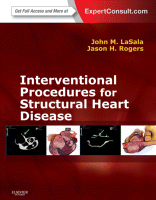Physical Address
304 North Cardinal St.
Dorchester Center, MA 02124

23.1 Key Points 1. Cardiovascular obstructions in adult congenital heart disease (CHD) often involve branch pulmonary artery stenosis and postsurgical baffles, homografts, and conduits. 2. Stenting various cardiovascular obstructions in adult CHD requires a good understanding of available stents and…

Patent ductus arteriosus (PDA), coronary fistulas, pulmonary arteriovenous malformations (PAVMs), and aortopulmonary collaterals (APCs) represent unwanted vascular communications that can potentially cause severe clinical sequelae such as heart failure, myocardial infarction, or even endarteritis. Although surgical ligation or expectant management…

Pulmonary hypertension (HTN) with end-stage pulmonary vascular disease results in right heart failure, low output, and death, with few therapeutic options other than lung transplantation. Opening of the atrial septum (most common), ventricular septum, or ductus arteriosus allows for right-to-left…

20.1 Embryology and Anatomy The foramen ovale is pivotal during intrauterine life and facilitates the passage of oxygenated blood from the placenta to the fetal circulatory system. The blood flow from the umbilical veins enters the right atrium through the…

Atrial fibrillation (AF) remains the most common arrhythmia encountered in clinical practice; it is estimated that by the year 2050 the number of patients in the United States may exceed 12 million. Traditionally, AF has been treated medically with the…

Although many transcatheter closure techniques are closely related, aortic, ventricular, and coronary pseudoaneurysms each involve unique approaches. Likewise, coronary fistulas are discussed separately. Most closure techniques are improvisations of methods applied in more commonly encountered congenital defects (e.g., atrial septal…

Ventricular septal defects (VSDs) are the most common congenital heart disease, accounting for 25% of all congenital heart defects and occurring in 3 to 3.5 infants per 1000 live births. Congenital VSDs often close spontaneously in childhood or are otherwise…

Atrial fibrillation (AF) is the most common cardiac arrhythmia, and a major cause of stroke in the elderly. An estimated 12 to 16 million Americans will have a diagnosis of AF by 2050. The risk of stroke attributable to AF…

15.1 Background The management of chronic pericardial effusions by cardiologists and cardiothoracic surgeons poses significant challenges and is burdened with limitations because of the generally moribund state of patients stricken with this condition. Malignancy and infection most commonly cause pericardial…

14.1 Key Points In appropriate patients with hypertrophic cardiomyopathy (HCM), alcohol septal ablation using contrast echocardiographic guidance causes targeted necrosis, thinning of the basal interventricular septum, and widening of the left ventricular outflow tract (LVOT) and relieves outflow tract obstruction.…